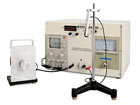E-Meter for Flexural Resonance of ConcreteThe E-Meter can determine flexural resonance of concrete under accelerated freezing and thawing cycles and aggressive environments, conforming to ASTM C-215 and C-666. It determines the resonant frequencies of the three modes of vibration and is the only method of calculating the following material parameters non destructively: such as Youngs Modulus of Elasticity, Modulus of Rigidity, Poissons Ratio and Damping Constant. Frequencies are automatically scanned in one of four ranges. It can handle specimen sizes up to 6 inches (150mm) in cross section and from 1.75 inches (45mm) to 28 inches (700mm) in length. A semi-automatic feature facilitates the fast identification of resonance.
Oscillator frequency range: 10 Hz to 100 kHz in 4 switched range |
 |
SonometerASTM C215, C666 The Sonometer determines changes in resonant frequency of concrete specimens subjected to alternate cycles of freezing and thawing with the Humboldt Freeze-Thaw Cabinet. This apparatus closely follows design parameters set up over 40 years ago by the Portland Cement Association research laboratories. The original PCA design has been modified by changing to solid state circuitry and addition of a built-in cathode ray oscilloscope. No other resonant frequency system includes an oscilloscope despite being strongly recommended in ASTM C215 paragraph 4.2. Other systems offer an oscilloscope connection. The oscilloscope confirms that peak reading on meter is actual resonance and not a harmonic. The apparatus consists essentially of a driver and pickup circuit. Electrical power is converted by the driver into mechanical vibrations and these vibrations are imparted to the specimen under test. The amplitude and frequency of vibrations are controllable having respective ranges of 0 to 30 watts power and 400 to 12,000 cycles per second frequency with an accuracy of better than ± 2%. The actual frequency is displayed on a built-in digital counter. The driver is completely portable and comes with 6´ plug-in connecting cable. Resonant frequency can be determined by watching the voltmeter reach its highest point. The oscilloscope verifies resonance because the meter alone also reaches high points on harmonics. When resonance occurs, the actual number is digitally displayed on the frequency counter. The H-3175 Sonometer is the only system using a phono-type cartridge as a pickup. All other units use accelerometers, which require intimate contact with the test specimen. Changing accelerometer positions on the test specimen is time consuming. With the pickup and driver mounted on portable stands, it is not necessary to use a test bench, which is mandatory on other apparatus. This allows for greater flexibility in testing. A very detailed instruction manual accompanies each sonometer. The chassis measures 17 x 14 x 11". Standard voltage characteristics are 115/60/1. Shipping Weight: 55 lb (25kg); 8 cu. ft. |
 |

